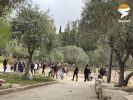Amidst the Israeli attacks witnessed in the Gaza Strip and Israel’s declaration of a genocidal war against the Gaza Strip with its stated objectives being of eliminating the Hamas Movement and targeting Hamas leaders both military and political including the assassination of some of its high-ranking members such as the members of the Movement’s political bureau; Osama Al-Mazini Jamila Al-Shanti Jawad Abu Shamala and Zakaria Abu Amr.
Since the first day of the Movement’s existence Israel has been targeting its leaders and members even before its official establishment in the 1980s. It has pursued its leaders through arrests deportations as well as continuous assassinations. The majority of the Movement’s top figures and dozens of leaders have been martyred as a result of the assassination policy.
Despite the Occupation’s assassination of the Movement’s leaders multiple times there are still people who believe in the conspiracy theory that Israel created Hamas to combat the nationalist movement. This claim lacks any logical basis and is closer to absurdity and intellectual deception. It is inconceivable that Israel for the sake of fighting the nationalist movement would seek to revive the religious movement which has historically been the first enemy of colonial forces and has been fought against and defeated over the years. We witnessed this throughout the period of liberation of all Arab and Islamic countries from colonial forces. In Sudan there was Muhammad Ahmad Al-Mahdi; in Libya there was Omar Mukhtar and Muhammad Idris Al-Senussi; in Algeria there was Abdelkader El Djezairi and in Palestine itself Sheikh Amin Al-Husseini the Grand Mufti of Jerusalem. It has always been the Islamic background that faced colonialism. It would be foolish to create a large enemy just to confront a smaller one.
The declaration of the Hamas Movement in 1987 as a struggle Movement came as a result of the global Islamic Movement. Prior to that the Muslim Brotherhood in Palestine sought to engage in real military action unofficially. The evidence of this is the arrest of Sheikh Ahmed Yassin “the founder of Hamas” in 1983 on charges of weapon storage. He was sentenced to thirteen years but was released in a prisoner exchange in 1985. In fact throughout the Muslim Brotherhood’s history there were attempts to establish a military situation to confront the Occupation. One of the most prominent figures involved in these attempts in the 1970s albeit unofficially was Sheikh Sayed Abu Musameh one of Hamas’s top leaders.
The Fatah Movement the backbone of the Palestinian nationalist movement in the seventies which was led back then by Yasser Arafat and after him Mahmoud Abbas had a close affinity to Muslim Brotherhood. Even some of Fatah’s founders were members of the Muslim Brotherhood most notably Abu Jihad Al-Wazir who was responsible for the youth sector in the Brotherhood. His initial experience in fighting the Occupation was linked to the Muslim Brotherhood whose volunteers emerged in 1948.
During Fatah’s presence in Jordan there was a military effort by the Islamic Movement known at the time as the “Sheikhs’ Bases” in 1968. This was based on an agreement between Fatah and the Muslim Brotherhood to allow the Brotherhood to train and establish independent bases in the Jordan Valley and conduct resistance activities under their cover including joint operations.
Later on when Hamas established itself as a prominent Palestinian resistance movement other Palestinian factions in particular the PLO started seeing Hamas as a serious threat to their domination of the Palestinian political scene. To face the growing support for Hamas they claimed that the Occupation allowed Hamas to emerge as a popular force within the Palestinian people. This claim is nothing short of absurdity because even when Muslim Brotherhood in Palestine was just a charitable and popular movement and had not evolved into Hamas it was strong and present in student activities and university elections competing with Fatah and the left. The difference in victory between the two was minimal.
Claims by the Israelis that they helped Hamas to grow to divide the Palestinian national movement is not proof that Hamas was created by Israel. It is a well-known fact that all colonial forces tried to play the game of divide and conquer to subdue the local people. Yet Hamas could not be held responsible for the enemy’s oppressive intentions. These attempts were carried out by the Occupation with Hamas Fatah and all Palestinian movements. In fact the establishment of the Palestinian Authority came in this context.
Israel used many strategies to break the Palestinian people including improving the Palestinian public’s standard of living and helping them to indulge in consumerism. Many Israeli leaders believed that if Israel gave the Palestinians something to fear for they would simply comply and would not be able to risk losing it. By allowing Qatari money into the Gaza Strip Netanyahu hoped this would make Hamas more involved in running people’s daily life and consolidate the division he created between the West Bank and the Gaza Strip; evidently he failed.
Nowadays amidst the war against Gaza Israeli propaganda tries to portray Hamas as a marginal and unpopular Movement which was created against the interests of the Palestinian people in order to undermine people’s trust in it. For some people all the wars fought by the Movement do not prove that the relationship between the two sides is a deadly one characterized by the highest levels of confrontation. If all this bloodshed and wars including the current ongoing war do not undermine this idea fundamentally it means that all human logic is worthless.
Yet Hamas still enjoys significant support from the Palestinian people the Arab street and the Islamic world. This is evidence of the failure of the Israeli propaganda which is illogical and used as a tool by the Occupation to tarnish the image of a formidable and strong opponent like Hamas.
– Dr Mohammad Makram Balawi is the Director General of League of Parliamentarians for alQuds (LP4Q). His article appeared in MEMO.













